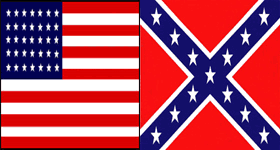 |
Civil War Battles |
|
State War Records |
| AL - AK - AZ - AR - CA - CO - CT - DE - FL - GA - HI - ID - IL - IN - IA - KS - KY - LA - MA - MD - ME - MI - MN - MS - MO - MT - NE - NV - NH - NJ - NM - NY - NC - ND - OH - OK - OR - PA - RI - SC - SD - TN - TX - UT - VT - VA - WA - WV - WI - WY |
The Battle of Falling Waters
July 6-16, 1863 in Williamsport, Maryland
 |
|||||||||||||||||||||
|
The Confederate retreat from Gettysburg began on July 4th as the defeated Army of Northern Virginia wearily filled the Pennsylvania and Maryland roads for 3 days, its wagon train of wounded alone stretching for 17 miles. Heavy downpours hampered the march, but Gen. Robert E. Lee's confederates reached the Potomac River at Willaimsport, Maryland on the afternoon of the 6th and continued to arrive into the morning hours of the 7th.
Meade caught up with the Confederate army at Monteray Pass but did not attack at first. The Union army managed to position themselves next to the Confederates in the dark and rain without being detected.
Just after 3:00 A.M., the Union cavalry came charging out of the dark into the rear of the wagon train and struck the Confederates. After a brief fight, the Confederates drove off the cavalry, but not before suffering even more casualties and slowing the withdrawal.
On the 7th, Imboden stopped Buford's Union cavalry from occupying Williamsport and destroying Confederate trains. Kilpatrick's cavalry division drove 2 Confederate cavalry brigades through Hagerstown before being forced to retire by the arrival of the rest of Stuart's command. Lee's infantry reached the rain-swollen Potomac River but could not cross, the pontoon bridge having been destroyed by a cavalry raid.
French got to Williamsport before the Confederates and destroyed the pontoon bridges as ordered. Knowing that it would take at least 6 days to get everybody across, including eguipment, Lee decided to make a stand against the Union army before he proceeded with his retreat. Lee's defenses were from Downsville around to Falling Waters on Concoteague Creek, both ends of the 5 mile line secured by water.
On the 11th, Lee entrenched a line, protecting the river crossings at Williamsport and waited for Meade's army to advance. On the 12th, Meade reached the vicinity and started placing his army in an offensive position. He soon probed the Confederate line. On the 13th, skirmishing was heavy along the lines as Meade positioned his forces for the final attack. Also on the same day, the Confederates tore down all the warehouses and buildings around their defensive line, and built some wooden bridges to cross the river, all the while waiting for the Union attack. Most of the Confederate army had crossed the river by early morning on the 14th when the Union attack began. Since the rains had swelled the river, making it unfordable, Lee ordered the construction of pontoon bridges while his infantry and artillery erected a defensive line from Williamsport to Falling Waters. Little occured except for cavalry clashes and skirmishes until the 12th, when Maj. Gen. George B. Meade's pursuing Army of the Potomac arrived opposite the Confederate position. The Federals, battered at Gettysburg as badly as the Confederates, simply entrenched before the Confederate works.
By the next day the Potomac was passable at Williamsport, and the Confederate engineers had completed the pontoon bridge at Falling Waters. Lee ordered the retreat. Under the cover of darkness, the Confederates crossed to Virginia in a skillfully executed move, and by 11:00 A.M. the next morning, all units had reached the south bank except for 2 divisions at Falling Waters.
Meade, meanwhile, had ordered a reconnaissance in force for 7:00 A.M. on the 14th. The advancing Federals found only abandoned works at Williamsport, while at Falling Waters the 2 Confederate divisions lay encamped over a mile from the river. Maj. Gen. John Buford's and Brig. Gen. H. Judson Kilpatrick's cavalry divisions led the Union advance at Falling Waters. Buford, approaching from the north, charged first.
Before his assault could develop, however, Kilpatrick permitted 2 small squadrons to attack the surprised Confederates of Maj. Gen. Henry Heth's division. In the melee, the Confederates, using rifles, fence rails, and axes, unhorsed most of these Union cavalrymen. Alerted, the Confederates fought stubbornly when Kilpatrick attacked with strength and Buford struck from the east. Before the 2 Confederate divisions could cross, they lost 719 officers and men as prisoners and abandoned 2 cannon. Their most grevious loss was Brig. Gen. James J. Pettigrew, who was mortally wounded in the initial attack.
Because of the Union failure to destroy the Confederate army, Union generals exaggerated considerably the Confederates losses at Falling Waters. The Union cavalry had only surprised Heth's soldiers, inflicting minimal casualties.
By the end of the day, Lee had his army back home in Virginia. Meade had stopped Lee's threat to Washington and prevented the Confederacy from achieving foreign recognition. No Union troops had been pulled out of the Vicksburg siege as Lee had hoped, and that city fell into Union hands on July 4, one day after the Battle of Gettysburg came to a conclusion.
Combined, the 2 armies suffered over 51,000 men killed, wounded, missing, and captured. Gettysburg was the costliest battle of the war and marked the turning point in the East. The Civil War would still not come to a conclusion for another 2 years, but the Confederates, for the most part, would remain on the defensives, while the Union army, once Grant takes command later in the year, would remain primarily on the offensive.
